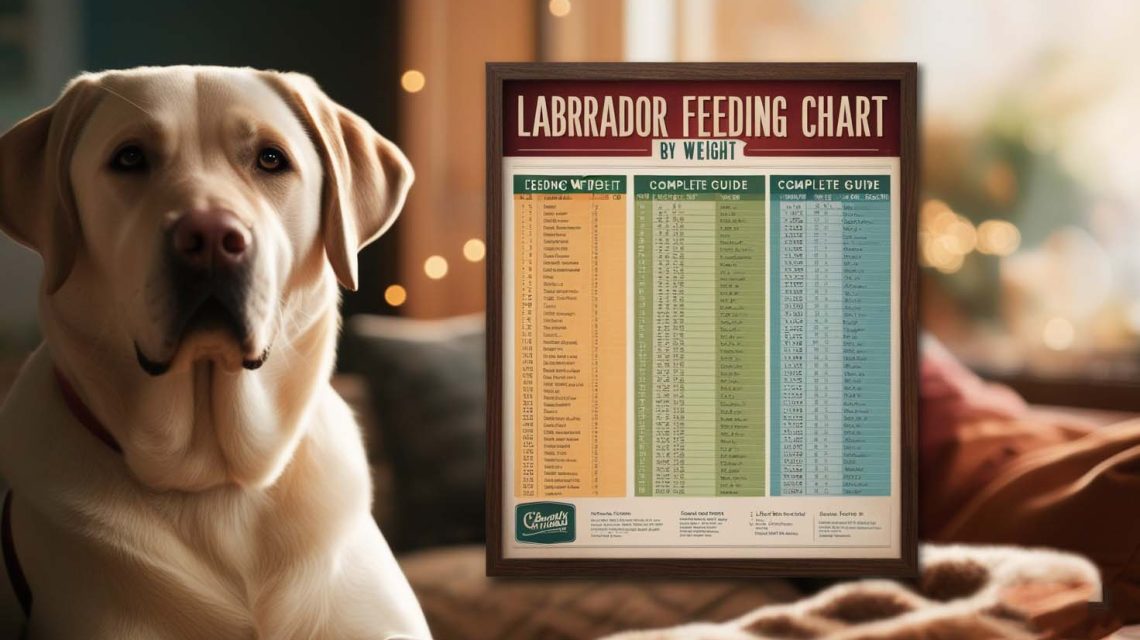Feeding your Labrador properly is one of the most important responsibilities as a pet owner. With their energetic nature and hearty appetites, Labradors require a balanced diet tailored to their weight and life stage. In this guide, we’ll explore the ideal Labrador feeding chart by weight, offering detailed tips and advice to keep your furry friend healthy and happy.
Why a Labrador Feeding Chart by Weight Matters
Labradors are prone to obesity if overfed or under-exercised. A feeding chart by weight ensures your dog receives the right amount of food to maintain an ideal weight, which is critical for preventing health issues like joint problems, diabetes, and heart disease. Tailoring portions to their size also provides the energy they need for an active lifestyle.
Labrador Feeding Chart by Weight and Age
Below is a general guideline for feeding Labradors based on their weight and age. Adjust portions based on activity levels, health conditions, and the specific type of food you use (kibble, wet food, or raw diet).
Puppy Feeding Chart (0–12 Months)
Labrador puppies require smaller, more frequent meals to support their rapid growth.
| Weight (lbs) | Age (months) | Meals per Day | Portion Size (cups) |
|---|---|---|---|
| 10–20 | 2–3 | 4 | 0.5–1 |
| 20–50 | 3–6 | 3 | 1–1.5 |
| 50–75 | 6–12 | 2–3 | 1.5–2 |
Adult Labrador Feeding Chart (1–7 Years)
Adult Labradors need balanced meals to maintain energy and avoid weight gain.
| Weight (lbs) | Activity Level | Meals per Day | Portion Size (cups) |
|---|---|---|---|
| 50–65 | Low | 2 | 2–2.5 |
| 65–80 | Moderate | 2 | 2.5–3 |
| 80+ | High | 2 | 3–3.5 |
Senior Labrador Feeding Chart (7+ Years)
As Labradors age, their metabolism slows, requiring fewer calories to avoid weight gain.
| Weight (lbs) | Activity Level | Meals per Day | Portion Size (cups) |
|---|---|---|---|
| 50–65 | Low | 2 | 1.5–2 |
| 65–80 | Moderate | 2 | 2–2.5 |
| 80+ | High | 2 | 2.5–3 |

Factors to Consider When Feeding Your Labrador
Type of Food
- Kibble: Choose high-quality kibble with real meat as the first ingredient. Avoid fillers like corn and soy.
- Wet Food: A great option for picky eaters but can be calorie-dense, so adjust portions.
- Raw Diet: Consult your vet before switching to raw feeding to ensure balanced nutrition.
Activity Level
Active Labradors require more calories than couch potatoes. Adjust their portions based on daily exercise routines.
Special Health Needs
Labradors with health issues, such as joint problems or allergies, may need specialized diets. Work with your vet to determine the best feeding plan.
Common Feeding Mistakes to Avoid
Overfeeding
Labradors are notorious for eating whatever is offered. Measure portions carefully and avoid free-feeding.
Skipping Meal Times
Stick to a consistent feeding schedule. Regular meal times help regulate digestion and prevent overindulgence.
Offering Too Many Treats
While treats are great for training, they add extra calories. Limit treats to no more than 10% of their daily intake.
Tips for Managing Your Labrador’s Diet
Monitor Weight Regularly
Weigh your Labrador monthly to ensure they maintain a healthy weight. Adjust food portions as needed.
Transitioning to New Food
Switch food gradually over 7–10 days to avoid stomach upset. Start by mixing small amounts of new food with their current diet.
Hydration Matters
Ensure your Labrador always has access to fresh water, especially if they eat dry kibble.
FAQs About Labrador Feeding Chart by Weight
1. How do I know if I’m feeding my Labrador enough?
Check their weight and body condition regularly. A healthy Labrador has a visible waistline and ribs that can be felt but not seen.
2. Should I feed my Labrador once or twice a day?
Twice a day is ideal for adult Labradors. Puppies require more frequent meals, while seniors may benefit from smaller, more regular portions.
3. Can I mix wet and dry food?
Yes, combining wet and dry food can provide variety and enhance flavor. Adjust portion sizes to avoid overfeeding.
4. What should I do if my Labrador is overweight?
Reduce portion sizes, switch to a lower-calorie food, and increase exercise. Consult your vet for a tailored weight-loss plan.
5. Is it okay to feed Labradors human food?
Some human foods, like cooked chicken or vegetables, are safe in moderation. Avoid toxic foods like chocolate, grapes, and onions.
6. How do I choose the best dog food for my Labrador?
Look for foods with high protein content, healthy fats, and minimal fillers. Consider your dog’s age, activity level, and health needs when selecting food.


